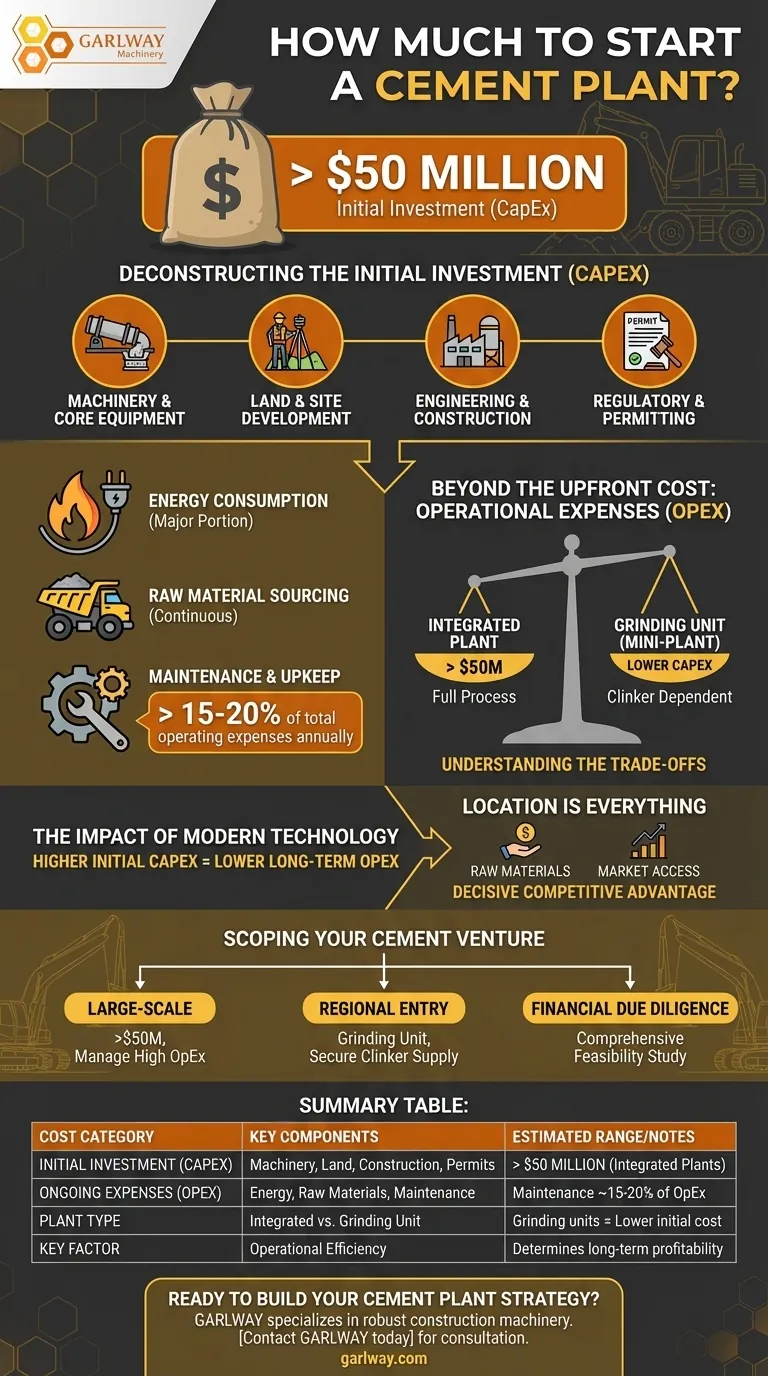To be direct, establishing a modern, state-of-the-art cement plant requires an initial investment that can easily exceed $50 million. This figure covers the core machinery, engineering, and construction needed to get the facility operational.
The true cost of a cement plant extends far beyond the initial price tag. Understanding the massive ongoing operational expenses, particularly for energy and maintenance, is the critical factor in determining long-term financial viability.

Deconstructing the Initial Investment (CapEx)
The multi-million dollar investment is not a single line item but a collection of significant capital expenditures. Each component is essential for building a functional and competitive facility.
Machinery and Core Equipment
This is the heart of the plant and the largest portion of the initial cost. Key equipment includes the rotary kiln for heating raw materials, crushers for breaking down limestone, ball mills for grinding, and sophisticated packaging and bagging systems.
Land and Site Development
Cement plants require substantial land, not just for the facility itself but also for quarrying raw materials like limestone. Costs include land acquisition, geological surveys to ensure resource quality, and extensive site preparation and infrastructure development.
Engineering and Construction
This covers the physical construction of all buildings, including the plant itself, storage silos for raw materials and finished cement, laboratories for quality control, and administrative offices.
Regulatory and Permitting
Securing the necessary environmental permits and operating licenses is a complex and costly process. These fees, along with associated legal and consulting costs, represent a significant upfront investment before construction can even begin.
Beyond the Upfront Cost: Operational Expenses (OpEx)
Once the plant is built, ongoing operational costs become the primary financial focus. These recurring expenses determine the plant's profitability day in and day out.
Energy Consumption
Cement production is one of the most energy-intensive industrial processes. The massive amount of fuel required to heat the kiln to over 1,400°C (2,550°F) constitutes a major portion of the plant's total operating budget.
Raw Material Sourcing
While some materials may be quarried on-site, the cost of extracting, transporting, and preparing limestone, clay, and other additives is a continuous expense.
Maintenance and Upkeep
The heavy machinery in a cement plant operates under extreme conditions and requires constant maintenance. As a crucial benchmark, annual maintenance can amount to 15% to 20% of total operating expenses.
Understanding the Trade-offs
The headline figure of over $50 million applies to a specific type of facility. The strategic choices you make regarding scale and technology will fundamentally alter your financial model.
Integrated Plants vs. Grinding Units
An integrated plant handles the entire process from quarrying raw materials to producing finished cement. These are the facilities that cost over $50 million. In contrast, a grinding unit (or mini-plant) simply buys clinker (the intermediate product) and grinds it into cement. This model has a dramatically lower initial investment but is dependent on clinker suppliers.
The Impact of Modern Technology
Investing in the latest, most efficient technology increases the initial CapEx. However, it can significantly lower long-term OpEx by reducing energy consumption and improving reliability, leading to lower maintenance costs over the life of the plant.
Location is Everything
The plant's location dictates two of its biggest costs: transportation of raw materials and distribution of the final product. A strategic location close to both limestone quarries and major construction markets can provide a decisive competitive advantage.
Scoping Your Cement Venture
Your investment strategy must be aligned with your specific business goals and the scale of your ambition.
- If your primary focus is a large-scale, integrated facility: Prepare for a capital-intensive project exceeding $50 million and develop a robust plan for managing high, long-term energy and maintenance costs.
- If your primary focus is a smaller, regional entry: Explore the feasibility of a grinding unit to significantly reduce initial capital requirements, but ensure you have a stable and cost-effective supply chain for clinker.
- If your primary focus is financial due diligence: Your first step must be a comprehensive feasibility study that models both initial CapEx and projected OpEx against realistic market pricing and demand.
Ultimately, a successful venture in this industry is built on a clear understanding that the initial investment is just the foundation for a business defined by its operational efficiency.
Summary Table:
| Cost Category | Key Components | Estimated Range/Notes |
|---|---|---|
| Initial Investment (CapEx) | Machinery, Land, Construction, Permits | > $50 Million for integrated plants |
| Ongoing Expenses (OpEx) | Energy, Raw Materials, Maintenance | Maintenance can be 15-20% of OpEx |
| Plant Type | Integrated Plant vs. Grinding Unit | Grinding units have lower initial cost |
| Key Factor | Operational Efficiency | Determines long-term profitability |
Ready to Build Your Cement Plant Strategy?
Navigating the multi-million dollar investment and complex operational challenges of a cement plant requires the right partner. GARLWAY specializes in providing robust and efficient construction machinery—including concrete batching plants, mixers, and heavy-duty equipment—to construction companies and contractors globally.
We help you build a foundation for success by focusing on machinery that enhances operational efficiency and reduces long-term costs.
Contact GARLWAY today for a consultation on how our equipment can be integral to your project's viability and profitability.
Visual Guide

Related Products
- HZS120 Ready Mix Concrete Batching Plant Commercial Mud Cement Mixer
- JW1000 Mobile Cement Mixer Concrete Mixer Truck and Batching Plant
- Hydraulic Concrete Mixer Machine Cement Mixing Equipment for Mixture Concrete
- HZS75 Concrete Batching Plant Cement Mixer Price Concrete Mixer Bunnings Mixing Plant
- HZS35 Small Cement Concrete Mixing Batch Plant
People Also Ask
- What are the advantages of a concrete plant? Achieve Consistent Quality & Efficiency for Large-Scale Projects
- How do you maintain a concrete batching plant? Maximize Uptime & Extend Equipment Life
- What are the advantages of ready mix concrete? Higher Quality, Efficiency & Cost Savings
- How does ready-mix work? A Guide to Efficient, High-Quality Concrete Delivery
- What are the disadvantages of ready mix concrete? Navigating Logistical and Cost Challenges


















